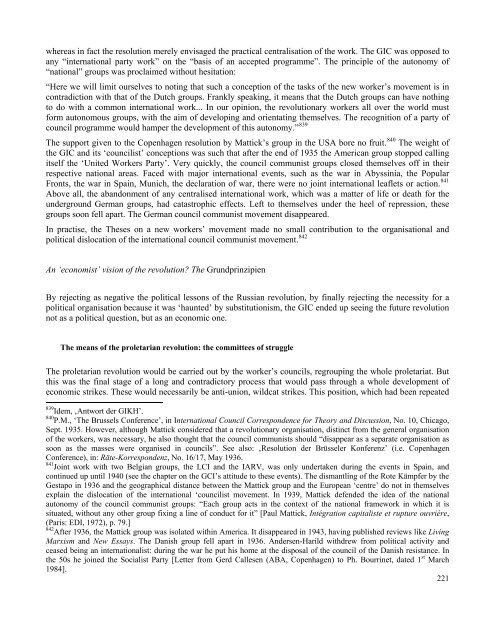The German-Dutch Communist Left - Libcom
The German-Dutch Communist Left - Libcom
The German-Dutch Communist Left - Libcom
You also want an ePaper? Increase the reach of your titles
YUMPU automatically turns print PDFs into web optimized ePapers that Google loves.
whereas in fact the resolution merely envisaged the practical centralisation of the work. <strong>The</strong> GIC was opposed to<br />
any “international party work” on the “basis of an accepted programme”. <strong>The</strong> principle of the autonomy of<br />
“national” groups was proclaimed without hesitation:<br />
“Here we will limit ourselves to noting that such a conception of the tasks of the new worker’s movement is in<br />
contradiction with that of the <strong>Dutch</strong> groups. Frankly speaking, it means that the <strong>Dutch</strong> groups can have nothing<br />
to do with a common international work... In our opinion, the revolutionary workers all over the world must<br />
form autonomous groups, with the aim of developing and orientating themselves. <strong>The</strong> recognition of a party of<br />
council programme would hamper the development of this autonomy.” 839<br />
<strong>The</strong> support given to the Copenhagen resolution by Mattick’s group in the USA bore no fruit. 840 <strong>The</strong> weight of<br />
the GIC and its ‘councilist’ conceptions was such that after the end of 1935 the American group stopped calling<br />
itself the ‘United Workers Party’. Very quickly, the council communist groups closed themselves off in their<br />
respective national areas. Faced with major international events, such as the war in Abyssinia, the Popular<br />
Fronts, the war in Spain, Munich, the declaration of war, there were no joint international leaflets or action. 841<br />
Above all, the abandonment of any centralised international work, which was a matter of life or death for the<br />
underground <strong>German</strong> groups, had catastrophic effects. <strong>Left</strong> to themselves under the heel of repression, these<br />
groups soon fell apart. <strong>The</strong> <strong>German</strong> council communist movement disappeared.<br />
In practise, the <strong>The</strong>ses on a new workers’ movement made no small contribution to the organisational and<br />
political dislocation of the international council communist movement. 842<br />
An ‘economist’ vision of the revolution? <strong>The</strong> Grundprinzipien<br />
By rejecting as negative the political lessons of the Russian revolution, by finally rejecting the necessity for a<br />
political organisation because it was ‘haunted’ by substitutionism, the GIC ended up seeing the future revolution<br />
not as a political question, but as an economic one.<br />
<strong>The</strong> means of the proletarian revolution: the committees of struggle<br />
<strong>The</strong> proletarian revolution would be carried out by the worker’s councils, regrouping the whole proletariat. But<br />
this was the final stage of a long and contradictory process that would pass through a whole development of<br />
economic strikes. <strong>The</strong>se would necessarily be anti-union, wildcat strikes. This position, which had been repeated<br />
839 Idem, ‚Antwort der GIKH’.<br />
840 P.M., ‘<strong>The</strong> Brussels Conference’, in International Council Correspondence for <strong>The</strong>ory and Discussion, No. 10, Chicago,<br />
Sept. 1935. However, although Mattick considered that a revolutionary organisation, distinct from the general organisation<br />
of the workers, was necessary, he also thought that the council communists should “disappear as a separate organisation as<br />
soon as the masses were organised in councils”. See also: ‚Resolution der Brüsseler Konferenz’ (i.e. Copenhagen<br />
Conference), in: Räte-Korrespondenz, No. 16/17, May 1936.<br />
841 Joint work with two Belgian groups, the LCI and the IARV, was only undertaken during the events in Spain, and<br />
continued up until 1940 (see the chapter on the GCI’s attitude to these events). <strong>The</strong> dismantling of the Rote Kämpfer by the<br />
Gestapo in 1936 and the geographical distance between the Mattick group and the European ‘centre’ do not in themselves<br />
explain the dislocation of the international ‘councilist movement. In 1939, Mattick defended the idea of the national<br />
autonomy of the council communist groups: “Each group acts in the context of the national framework in which it is<br />
situated, without any other group fixing a line of conduct for it” [Paul Mattick, Intégration capitaliste et rupture ouvrière,<br />
(Paris: EDI, 1972), p. 79.]<br />
842 After 1936, the Mattick group was isolated within America. It disappeared in 1943, having published reviews like Living<br />
Marxism and New Essays. <strong>The</strong> Danish group fell apart in 1936. Andersen-Harild withdrew from political activity and<br />
ceased being an internationalist: during the war he put his home at the disposal of the council of the Danish resistance. In<br />
the 50s he joined the Socialist Party [Letter from Gerd Callesen (ABA, Copenhagen) to Ph. Bourrinet, dated 1 st March<br />
1984].<br />
221
















